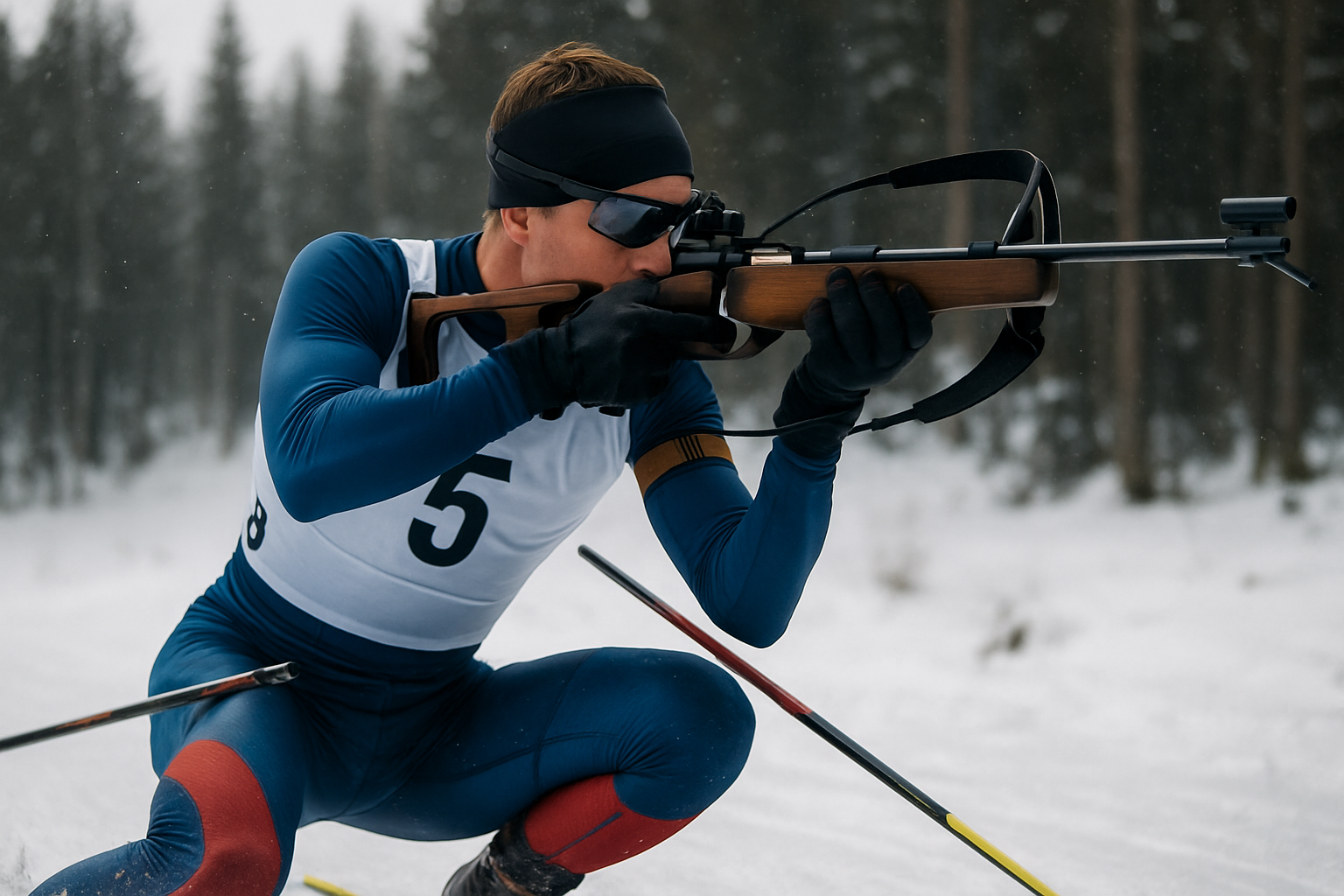Nordic Combined: The Ultimate Winter Sport Challenge
Soaring through the air, then gliding across snow-covered terrain, Nordic Combined athletes showcase a unique blend of courage and endurance. This lesser-known winter sport merges the breathtaking spectacle of ski jumping with the grueling test of cross-country skiing, creating a thrilling competition that pushes human limits. As we delve into the world of Nordic Combined, we'll uncover its rich history, technical intricacies, and the extraordinary athletes who have mastered this demanding discipline.

The origins of Nordic Combined can be traced back to the 19th century in Norway, where skiing was not just a recreational activity but an essential part of daily life. The sport emerged as a natural progression from the practical skills needed for survival in harsh winter conditions. Norwegian soldiers would often combine skiing and shooting as part of their training, laying the groundwork for what would eventually become Nordic Combined.
In 1892, the first official Nordic Combined competition was held at the Holmenkollen Ski Festival in Oslo, Norway. This event marked the beginning of a sport that would captivate audiences and challenge athletes for generations to come. The competition format has evolved over the years, but the core elements of ski jumping and cross-country skiing have remained constant.
The inclusion of Nordic Combined in the 1924 Winter Olympics in Chamonix, France, was a significant milestone for the sport. It was one of the original six sports featured in the first Winter Games, highlighting its importance in the winter sports landscape. Since then, Nordic Combined has been a regular fixture in the Olympic program, with various events added over the years to showcase different aspects of the sport.
The Art of Ski Jumping
At the heart of Nordic Combined lies the spectacular discipline of ski jumping. This phase of the competition requires a unique blend of courage, technique, and split-second timing. Athletes launch themselves from a towering ski jump, soaring through the air at speeds exceeding 60 miles per hour, aiming to achieve maximum distance and style points.
The ski jumping portion of Nordic Combined begins with the in-run, where athletes gather speed as they descend the jump. Proper positioning during this phase is crucial, as it sets the foundation for a successful jump. Skiers adopt an aerodynamic tuck position, minimizing air resistance while maximizing acceleration.
As they approach the take-off, athletes must execute a precise and explosive movement to propel themselves into the air. This moment requires impeccable timing and body control. The transition from the in-run to the flight phase is often described as one of the most technically challenging aspects of the sport.
Once airborne, ski jumpers enter the flight phase, where aerodynamics play a critical role. Athletes adopt a V-style position, spreading their skis to form a ‘V’ shape. This technique, pioneered in the 1980s, allows jumpers to generate more lift and achieve greater distances compared to the traditional parallel ski position.
The landing is the final and often most dangerous part of the jump. Athletes must time their landing perfectly, transitioning from flight to ground contact smoothly to avoid injury and maximize their distance. A telemark landing, where one foot is placed ahead of the other in a lunging position, is the ideal technique and can earn additional style points.
Cross-Country Skiing: The Test of Endurance
Following the adrenaline rush of ski jumping, Nordic Combined athletes face an entirely different challenge: cross-country skiing. This phase of the competition tests endurance, technique, and tactical acumen over grueling distances ranging from 5 to 15 kilometers, depending on the event format.
The cross-country portion of Nordic Combined typically employs the freestyle technique, allowing skiers to use the more efficient skating stride. This technique involves pushing off the inside edge of each ski in a V-shaped pattern, similar to ice skating. Mastery of this technique is essential for success in Nordic Combined, as it allows athletes to maintain high speeds over long distances.
Proper pacing is crucial in the cross-country phase. Athletes must carefully manage their energy reserves, considering factors such as course profile, weather conditions, and their starting position based on the ski jumping results. Strategic decisions about when to push the pace and when to conserve energy can make the difference between victory and defeat.
The physical demands of cross-country skiing in Nordic Combined are immense. Athletes must possess exceptional cardiovascular fitness, muscular endurance, and mental toughness. The ability to maintain form and technique while fatigued is a hallmark of elite Nordic Combined skiers.
Equipment plays a significant role in cross-country performance. Skis must be carefully selected and prepared to match the snow conditions, with factors such as temperature, humidity, and snow crystal structure all influencing ski choice and wax application. The intricate science of ski preparation is a crucial aspect of Nordic Combined that can significantly impact an athlete’s performance.
Training for Nordic Combined: A Balancing Act
Preparing for Nordic Combined presents a unique challenge for athletes and coaches. The sport demands excellence in two disciplines that require vastly different physical attributes and technical skills. Balancing the training load between ski jumping and cross-country skiing is a delicate art that has evolved significantly over the years.
Ski jumping training focuses on developing explosive power, spatial awareness, and precise technique. Athletes spend countless hours perfecting their in-run position, take-off timing, and flight mechanics. Dry-land training often includes gymnastics and trampoline work to improve body control and air awareness. Strength training, particularly for the legs and core, is essential to generate the power needed for a successful jump.
Cross-country ski training, on the other hand, emphasizes building a robust aerobic base and muscular endurance. Long, slow-distance training forms the foundation of many athletes’ programs, supplemented by high-intensity interval work to improve lactate threshold and VO2 max. Roller skiing is a common off-snow training method, allowing athletes to maintain technique and fitness year-round.
Mental preparation is equally important in Nordic Combined. Athletes must be able to transition quickly from the high-adrenaline, precision-focused mindset of ski jumping to the steady, pain-embracing mentality required for cross-country skiing. Visualization techniques, mindfulness training, and sports psychology sessions are often incorporated into athletes’ training regimens to enhance mental resilience and performance under pressure.
Periodization plays a crucial role in Nordic Combined training. Coaches must carefully structure the training year to ensure athletes peak for major competitions while maintaining proficiency in both disciplines. This often involves alternating focus between ski jumping and cross-country skiing throughout the season, with integrated training sessions that combine elements of both disciplines.
Competition Formats and Scoring
Nordic Combined events come in several formats, each presenting unique challenges and strategic considerations. The most common formats in international competition are the Individual Gundersen, Team Event, and Team Sprint.
The Individual Gundersen format begins with a ski jumping round, where athletes are awarded points based on distance and style. These points are then converted into time differences for the cross-country portion of the event. The athlete with the best jump starts first, with subsequent competitors starting based on their time behind the leader. This handicap system ensures an exciting race where the first athlete to cross the finish line is the overall winner.
The Team Event features four athletes per team, with each member performing one jump. The total points from these jumps determine the starting order and time differences for the subsequent 4 x 5 km cross-country relay. This format emphasizes both individual performance and team tactics, as nations must field a well-rounded squad capable of excelling in both disciplines.
The Team Sprint, introduced more recently, involves two athletes per team alternating laps in both the ski jumping and cross-country phases. This fast-paced format adds an element of excitement and unpredictability to Nordic Combined competitions.
Scoring in Nordic Combined is a complex system that balances performance in both disciplines. In ski jumping, athletes are awarded points based on distance and style, with adjustments made for wind conditions and starting gate changes. The cross-country phase uses a simple first-to-finish scoring system, with the handicap start ensuring that the overall winner is the athlete who performs best across both disciplines.
The Global Landscape of Nordic Combined
While Nordic Combined has its roots in Scandinavia, the sport has gained popularity in several nations across Europe, North America, and Asia. Traditional powerhouses like Norway, Germany, and Austria continue to dominate international competitions, but countries such as Japan, France, and the United States have made significant strides in recent years.
The FIS Nordic Combined World Cup serves as the premier circuit for the sport, featuring competitions throughout the winter season at venues across Europe and occasionally in North America and Asia. The overall World Cup title is one of the most prestigious achievements in Nordic Combined, rewarding consistent performance across various events and conditions.
At the Olympic level, Nordic Combined has been a constant presence since 1924. The program has expanded over the years to include team events and different individual formats. However, it remains one of the few Winter Olympic sports without a women’s event, although efforts are ongoing to introduce women’s Nordic Combined at the Olympic level.
The development of Nordic Combined faces several challenges, including limited global participation compared to other winter sports and the high cost of facilities and equipment. Many nations lack the specialized ski jumping hills required for training and competition, limiting the sport’s growth potential in these areas.
Despite these challenges, Nordic Combined continues to evolve and adapt. Innovations in equipment technology, training methodologies, and competition formats are helping to keep the sport relevant and exciting for both participants and spectators. The introduction of summer Grand Prix events on plastic jumping hills and roller skis has extended the competitive season and increased visibility for the sport.
The Future of Nordic Combined
As Nordic Combined looks to the future, several key trends and developments are shaping the sport’s trajectory. One of the most significant is the push for gender equality, with increasing efforts to establish women’s Nordic Combined at the highest levels of competition. While women’s ski jumping was added to the Olympic program in 2014, Nordic Combined remains the only Winter Olympic sport without female participation. The inclusion of women’s events would not only promote equality but also broaden the sport’s appeal and talent pool.
Technological advancements continue to play a crucial role in the evolution of Nordic Combined. Innovations in ski jumping suit design, ski materials, and waxing techniques are constantly pushing the boundaries of performance. In cross-country skiing, improvements in ski construction and grip technologies are enhancing efficiency and speed. As these technologies develop, governing bodies face the ongoing challenge of balancing innovation with fair competition.
Climate change presents a significant challenge for Nordic Combined and winter sports in general. Rising temperatures and unpredictable weather patterns are affecting snow conditions and the viability of certain venues. This has led to increased reliance on artificial snow and the exploration of more sustainable practices in event organization. Some competitions are now held on refrigerated tracks or indoor facilities, raising questions about the future landscape of the sport.
The globalization of Nordic Combined is another area of focus for the sport’s governing bodies. Efforts to expand the sport’s reach beyond its traditional European strongholds include development programs, coach education initiatives, and the strategic placement of international competitions. The goal is to cultivate new talent and increase global participation, ensuring a diverse and competitive field for years to come.
Media coverage and spectator engagement are crucial for the sport’s growth and sustainability. Nordic Combined faces the challenge of making a complex, multi-disciplinary event accessible and exciting for casual viewers. Innovations in broadcasting technology, such as real-time performance data and augmented reality graphics, are being explored to enhance the viewing experience and attract new fans.
The athletic demands of Nordic Combined are also evolving. As performances in both ski jumping and cross-country skiing continue to improve, athletes must adapt their training and preparation strategies. There is an ongoing debate within the sport about whether to specialize more in one discipline or maintain a balanced approach. This tension between specialization and versatility may shape the future of Nordic Combined athlete development.
The Enduring Appeal of Nordic Combined
Nordic Combined stands as a unique and compelling testament to human athletic versatility. It challenges athletes to excel in two vastly different disciplines, demanding a rare combination of courage, power, endurance, and tactical acumen. This blend of skills, along with the sport’s rich history and cultural significance, ensures its continued relevance in the world of winter sports.
As Nordic Combined evolves to meet the challenges of the 21st century, it remains true to its core identity as the ultimate test of winter sports prowess. The sport continues to captivate audiences with its blend of high-flying spectacle and grueling endurance, while also serving as a living link to the practical origins of skiing in Scandinavian culture.
The future of Nordic Combined will be shaped by its ability to adapt to changing environmental conditions, embrace technological innovations, and expand its global reach. As the sport works towards greater inclusivity and sustainability, it has the potential to inspire new generations of athletes and fans alike.
For those who compete in Nordic Combined, the sport offers a unique and rewarding challenge. It demands not only physical excellence but also mental fortitude and strategic thinking. The ability to transition between the precision of ski jumping and the endurance of cross-country skiing sets Nordic Combined athletes apart as some of the most versatile winter sports competitors.
As we look to the future, Nordic Combined stands poised to continue its evolution while honoring its rich heritage. Whether through the introduction of new events, the expansion of women’s competition, or the adoption of cutting-edge technologies, the sport will undoubtedly continue to push the boundaries of human performance.
For spectators and enthusiasts, Nordic Combined offers a thrilling and multifaceted sporting experience. From the heart-stopping moments of ski jumping to the tactical battles of cross-country racing, it provides a unique blend of excitement and athleticism. As the sport continues to grow and develop, it promises to remain a captivating and integral part of the winter sports landscape for years to come.
In essence, Nordic Combined embodies the spirit of winter sports at its purest: a celebration of human skill, courage, and endurance set against the backdrop of snow-covered landscapes. It challenges us to appreciate the diverse skills required to master multiple disciplines and reminds us of the incredible adaptability of the human body and mind.
As we celebrate the achievements of Nordic Combined athletes and look forward to the sport’s future, we are reminded of the enduring appeal of winter sports. In a world of increasing specialization, Nordic Combined stands as a powerful symbol of versatility and all-around athletic excellence. It continues to inspire and challenge, pushing the boundaries of what is possible on snow and in the air, and inviting us all to marvel at the heights of human potential.





